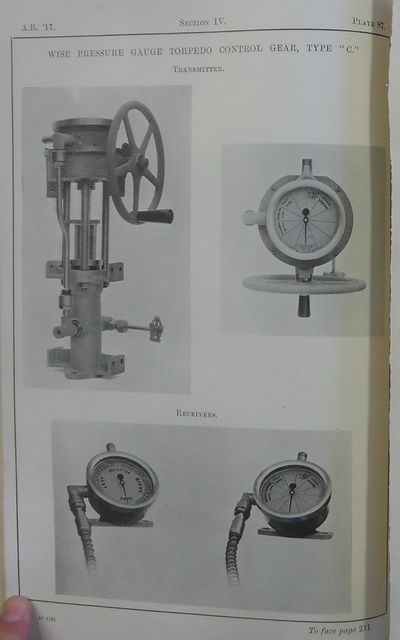Wise Pressure Telegraphy System

Wise's Pressure Telegraphy System was an hydraulically actuated system of remotely indicating fire and torpedo control information between different stations on a ship.
It was based on existing patents held by Engineer Lieutenant Commander A. S. Wise and adapted by Engineer Lieutenant Commander F. S. Carlisle of H.M.S. Morris, a new ship which lacked a means of communicating ranges from the bridge to guns.[2]
Original Concept
The system was a simple one of using a hydraulic medium of half glycerine and half water to communicate between stations. The transmitter was a screw-valve and a repeat indicating gauge, and one or more remote indicating gauges to act as receivers. In effect, the man working the transmitter could indicate the meaning of any one of a number of messages arrayed around the circumference of the identical gauge dials.
The first installation used only rigid piping, which placed some limitations on where the gauges could be placed. It proved highly reliable in nine months of service under all weather conditions.[3]
Adapted for Torpedo Control

The design was changed to separate gauges for deflection and orders prior to adoption.
By the end of 1915, Captain (D) Wilmot S. Nicholson of the Tenth Destroyer Flotilla had suggested that the system be adapted for torpedo control. Under this scheme, the dial's indications were no longer a simple scalar, as it was when conveying ranges, but had several regions for various purposes. Rather, the dial was as shown to the right, allowing enemy inclination, enemy speed, and simple training and firing orders to be communicated, albeit while requiring these modes of use to be used in alternation with some delay and possibility of confusion.
Trials
An initial Type A design with below-deck piping proved to be too slow to transmit orders, prone to leaking, and tiring to work. A follow-on Type B kept the piping above deck and featured a larger transmitting pump displacement, a smaller hand wheel to work, and illuminated dials.[5] Types A and B had large, 10 inch dials.[6]
In 1916, twenty such sets (Types A and B) had been fitted for trial:[7]
| Type A |
| ||||||||||||||||
| Type B |
|
By the end of 1916, the "Type B" systems seemed a substantial, but not complete success. Gauges sometimes got out of step, or the needles vibrated, but pressurizing the fluid and greater care in assembly seemed to help.
It was resolved to modify them to support the shift to deflection aiming by removing enemy speed and inclination in favor of torpedo deflection, and to use a second, separate network for conveying orders so the one indication would not have to fly between the various uses.[8]
Adoption

As a result of the trials, there was confidence that some light cruisers and destroyers already fitted should receive refined Type C versions of the system, but that Barr and Stroud would generally predominate with a lesser contribution of Chadburn for those other light cruisers with submerged tubes. Type C systems had smaller 5 inch dials than the earlier systems, required fewer turns of the transmitter handle, reduced vibration of needles, and incorporated internal illumination of the dials.[10]
In refining the Wise system, it was appreciated that a means had to be provided by which the torpedomen could indicate that they had acted upon the pressure-transmitted orders. It was decided that this was to be an electrical system of Barr and Stroud design.
At the end of 1916, it was decided that only the four ships with the "Type A" systems (see table above) were to be upgraded to "Type C". Those 16 ships with "Type B" would have their gauges converted to indicate deflection only, and a mechanical Chadburn's Torpedo Order Telegraph added to convey orders and an electrical system used to reply. Additionally, the light cruisers would have separate networks for port and starboard, creating a need in such cases for eight pressure networks and four electrical networks in those ships that had after control positions.[11]
In 1917, Type C systems were fitted in Inconstant and a number of destroyers, using independent systems for orders and deflection to avoid confusion and serial movements of the indicator. Torpedo Order 76 of 1917 outlined how to erect and maintain these systems.
Destroyer classes from Acorn to Laforey (more than 70 ships) eventually relied on Wise pressure systems for their fire control.[12]
See Also
Footnotes
- ↑ Annual Report of the Torpedo School, 1915. Figure 1, p. 243.
- ↑ Annual Report of the Torpedo School, 1915. pp. 242-243.
- ↑ Annual Report of the Torpedo School, 1915. p. 244.
- ↑ Annual Report of the Torpedo School, 1915. Figure 2, p. 243.
- ↑ Annual Report of the Torpedo School, 1916. pp. 30-31.
- ↑ Annual Report of the Torpedo School, 1917. p. 211.
- ↑ Annual Report of the Torpedo School, 1916. p. 30.
- ↑ Annual Report of the Torpedo School, 1916. p. 31.
- ↑ Annual Report of the Torpedo School, 1917. Plate 87.
- ↑ Annual Report of the Torpedo School, 1917. p. 211.
- ↑ Annual Report of the Torpedo School, 1916. pp. 30-31. I am not sure that the port and starboard facet applies to any but Inconstant.
- ↑ Technical History and Index Vol. 4, Part 34, pp. 15-16.
Bibliography
- H.M.S. Vernon. (Jan 1916) Annual Report of the Torpedo School, 1915. C.B. 1166. Copy 1025 at The National Archives. ADM 189/35.
- H.M.S. Vernon. Annual Report of the Torpedo School, 1916. Originally C.B. 1329. Copy 4 at The National Archives. ADM 189/36.